Textile Bandwidth-Enhanced Coupled-Mode Substrate-Integrated Cavity Antenna with Slot
Abstract
:1. Introduction
2. Antenna Topology and Design
2.1. Baisc HMSIC and CMSIC Antennas
2.2. CMSIC Antenna with Slot
2.3. Parametric Analysis
2.4. Mutual Effects between Antenna and Human Body
3. Prototype Fabrication and Measured Results
- Design the pattern for the embroidered sidewalls with the PE-DESIGN software.
- Cut the PF-4 foam sheet and conductive fabric NCS95R-CR into designed shapes for the substrate, top layer and ground plane, respectively.
- Glue the top layer and the ground plane onto the top and bottom surface of the substrate.
- Embroider the sidewalls with the designed pattern using the computerized embroidery machine Brother NV950.
- Install the SMA connector with conductive epoxy CircuitWorks CW2460.
4. Conclusions
Author Contributions
Funding
Data Availability Statement
Conflicts of Interest
References
- Galehdar, A.; Thiel, D.V. Flexible, light-weight antenna at 2.4 GHz for athlete clothing. In Proceedings of the 2007 IEEE Antennas and Propagation Society International Symposium, Honolulu, HI, USA, 9–15 June 2007. [Google Scholar]
- Lin, X.; Chen, Y.; Gong, Z.; Seet, B.; Huang, L.; Lu, Y. Ultrawideband textile antenna for wearable microwave medical imaging applications. IEEE Trans. Antennas Propag. 2020, 68, 4238–4249. [Google Scholar] [CrossRef]
- Lee, H.; Tak, J.; Choi, J. Wearable antenna integrated into military berets for indoor/outdoor positioning system. IEEE Antennas Wirel. Propag. Lett. 2017, 16, 1919–1922. [Google Scholar] [CrossRef]
- Hertleer, C.; Rogier, H.; Vallozzi, L.; Langenhove, L.V. A textile antenna for off-body communication integrated into protective clothing for firefighters. IEEE Trans. Antennas Propag. 2009, 57, 919–925. [Google Scholar] [CrossRef]
- Yan, S.; Soh, P.J.; Vandenbosch, G.A.E. Made to be worn. Electron. Lett. 2014, 50, 420. [Google Scholar]
- Agneessens, S.; Lemey, S.; Vervust, T.; Rogier, H. Wearable, small, and robust: The circular quarter-mode textile antenna. IEEE Antennas Wirel. Propag. Lett. 2015, 14, 1482–1485. [Google Scholar] [CrossRef] [Green Version]
- Yan, S.; Volskiy, V.; Vandenbosch, G.A.E. Compact dual-band textile PIFA for 433-MHz/2.4-GHz ISM bands. IEEE Antennas Wirel. Propag. Lett. 2017, 16, 2436–2439. [Google Scholar] [CrossRef]
- Simorangkir, R.B.V.B.; Yang, Y.; Matekovits, L.; Esselle, K.P. Dual-band dual-mode textile antenna on PDMS substrate for body-centric communications. IEEE Antennas Wirel. Propag. Lett. 2017, 16, 677–680. [Google Scholar] [CrossRef]
- Mao, C.-X.; Vital, D.; Werner, D.H.; Wu, Y.; Bhardwaj, S. Dual-polarized embroidered textile armband antenna array with omnidirectional radiation for on-/off-body wearable applications. IEEE Trans. Antennas Propag. 2019, 68, 2575–2584. [Google Scholar] [CrossRef]
- Deslandes, D.; Wu, K. Integrated microstrip and rectangular waveguide in planar form. IEEE Microw. Wirel. Compon. Lett. 2001, 11, 68–70. [Google Scholar] [CrossRef]
- Yan, S.; Soh, P.J.; Vandenbosch, G.A.E. Dual-band textile MIMO antenna based on substrate-integrated waveguide (SIW) technology. IEEE Trans. Antennas Propag. 2015, 63, 4640–4647. [Google Scholar] [CrossRef]
- Hong, Y.; Tak, J.; Choi, J. An all-textile SIW cavity-backed circular ring-slot antenna for WBAN applications. IEEE Antennas Wirel. Propag. Lett. 2016, 15, 1995–1999. [Google Scholar] [CrossRef]
- Hong, W.; Liu, B.; Wang, Y.; Lai, Q.; Tang, H.; Yin, X.X.; Dong, Y.D.; Zhang, Y.; Wu, K. Half-mode substrate-integrated waveguide: A new guided wave structure for microwave and millimeter wave application. In Proceedings of the 2006 Joint 31st International Conference on Infrared Millimeter Waves and 14th International Conference on Teraherz Electronics, Shanghai, China, 18–22 September 2006. [Google Scholar]
- Lai, Q.; Fumeaux, C.; Hong, W.; Vahldieck, R. Characterization of the propagation properties of the half-mode substrate integrated waveguide. IEEE Trans. Microw. Theory Technol. 2009, 57, 1996–2004. [Google Scholar]
- Dong, Y.; Itoh, T. Composite right/left-handed substrate integrated waveguide and half mode substrate integrated waveguide leaky-wave structures. IEEE Trans. Antennas Propag. 2011, 59, 767–775. [Google Scholar] [CrossRef]
- Zhu, X.; Guo, Y.; Wu, W. Miniaturized dual-band and dual-polarized antenna for MBAN applications. IEEE Trans. Antennas Propag. 2016, 64, 2805–2814. [Google Scholar] [CrossRef]
- Agneessens, S. Coupled eighth-mode substrate integrated waveguide antenna: Small and wideband with high-body antenna isolation. IEEE Access 2018, 6, 1595–1602. [Google Scholar] [CrossRef]
- Kaufmann, T.; Fumeaux, C. Wearable textile half-mode substrate-integrated cavity antenna using embroidered vias. IEEE Antennas Wirel. Propag. Lett. 2013, 12, 805–808. [Google Scholar] [CrossRef]
- Liu, F.-X.; Kaufmann, T.; Xu, Z.; Fumeaux, C. Wearable applications of quarter-wave patch and half-mode cavity antennas. IEEE Antennas Wirel. Propag. Lett. 2014, 14, 1478–1481. [Google Scholar] [CrossRef]
- Caytan, O.; Lemey, S.; Agneessens, S.; Ginste, D.V.; Demeester, P.; Loss, C.; Salvado, R.; Rogier, H. Half-mode substrate-integrated-waveguide cavity-backed slot antenna on cork substrate. IEEE Antennas Wirel. Propag. Lett. 2016, 15, 162–165. [Google Scholar] [CrossRef]
- Pinapati, S.P.; Ranasinghe, D.C.; Fumeaux, C. Bandwidth enhanced dual-band half-mode substrate-integrated cavity antenna. In Proceedings of the 2018 Australian Microwave Symposium, Brisbane, Australia, 6–7 February 2018. [Google Scholar]
- Gao, G.; Yang, C.; Hu, B.; Zhang, R.; Wang, S. A wide-bandwidth wearable all-textile PIFA with dual resonance modes for 5 GHz WLAN applications. IEEE Trans. Antennas Propag. 2019, 67, 4206–4211. [Google Scholar] [CrossRef]
- Cui, J.; Liu, F.-X.; Yin, H.; Zhao, L. Textile via-loaded bandwidth-enhanced half-mode substrate-integrated cavity antenna for WLAN communications. IEEE Trans. Antennas Propag. 2022, 1. [Google Scholar] [CrossRef]
- Jiang, X.; Zhang, Z.; Li, Y.; Feng, Z. A novel null scanning antenna using even and odd modes of a shorted patch. IEEE Trans. Antennas Propag. 2014, 62, 1903–1909. [Google Scholar] [CrossRef]
- Mastura Zainarry, S.N.; Chen, S.J.; Fumeaux, C. A pattern-reconfigurable single-element microstrip antenna. In Proceedings of the 2018 IEEE Radio and Antenna Days of the Indian Ocean (RADIO), Wolmar, Mauritius, 15–18 October 2018. [Google Scholar]
- Tian, H.; Dhwaj, K.; Jiang, L.J.; Itoh, T. Beam scanning realized by coupled modes in a single-patch antenna. IEEE Antennas Wirel. Propag. Lett. 2018, 17, 1077–1080. [Google Scholar] [CrossRef]
- Liu, F.-X.; Dou, W.-B.; Cui, J.; Chen, S.J.; Fumeaux, C. A concept of pattern-reconfigurable single-element antenna based on half-mode substrate-integrated cavity. In Proceedings of the 2020 14th European Conference on Antennas and Propagation (EuCAP), Copenhagen, Denmark, 15–20 March 2020. [Google Scholar]
- Cui, J.; Liu, F.-X.; Zhao, L.; Dou, W. Textile fixed-frequency pattern-reconfigurable coupled-mode substrate-integrated cavity antenna. IEEE Antennas Wirel. Propag. Lett. 2022, 1–4. [Google Scholar] [CrossRef]
- Hasgall, P.A.; Di Gennaro, F.; Baumgartner, C.; Neufeld, E.; Lloyd, B.; Gosselin, M.C.; Payne, D.; Klingenböck, A.; Kuster, N. IT’IS Database for Thermal and Electromagnetic Parameters of Biological Tissues, Version 4.1; IT’IS Foundation: Zurich, Switzerland, 2022. [Google Scholar] [CrossRef]
- Yaghjian, A.; Best, S. Impedance, bandwidth, and Q of antennas. IEEE Trans. Antennas Propag. 2005, 53, 1298–1324. [Google Scholar] [CrossRef]
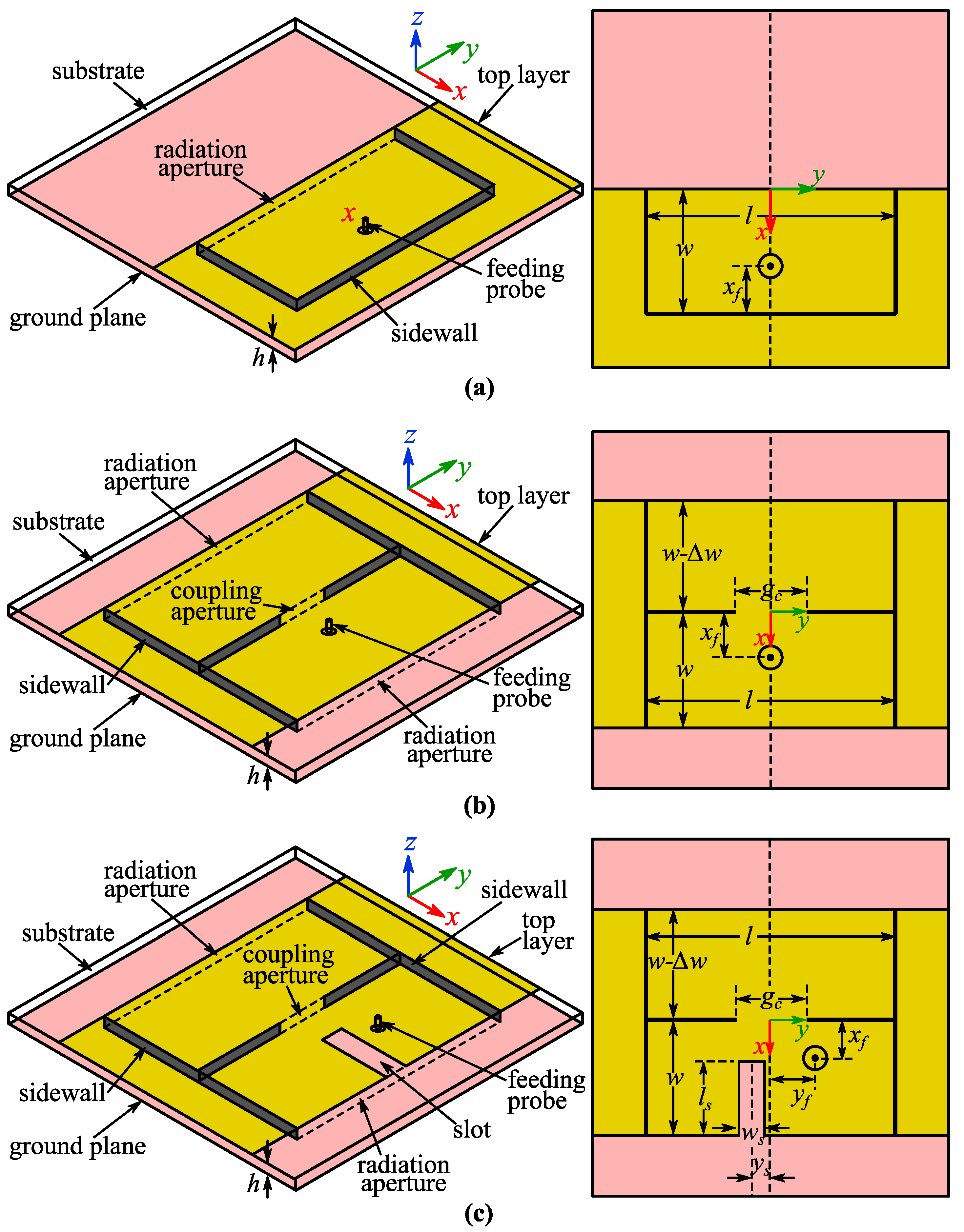



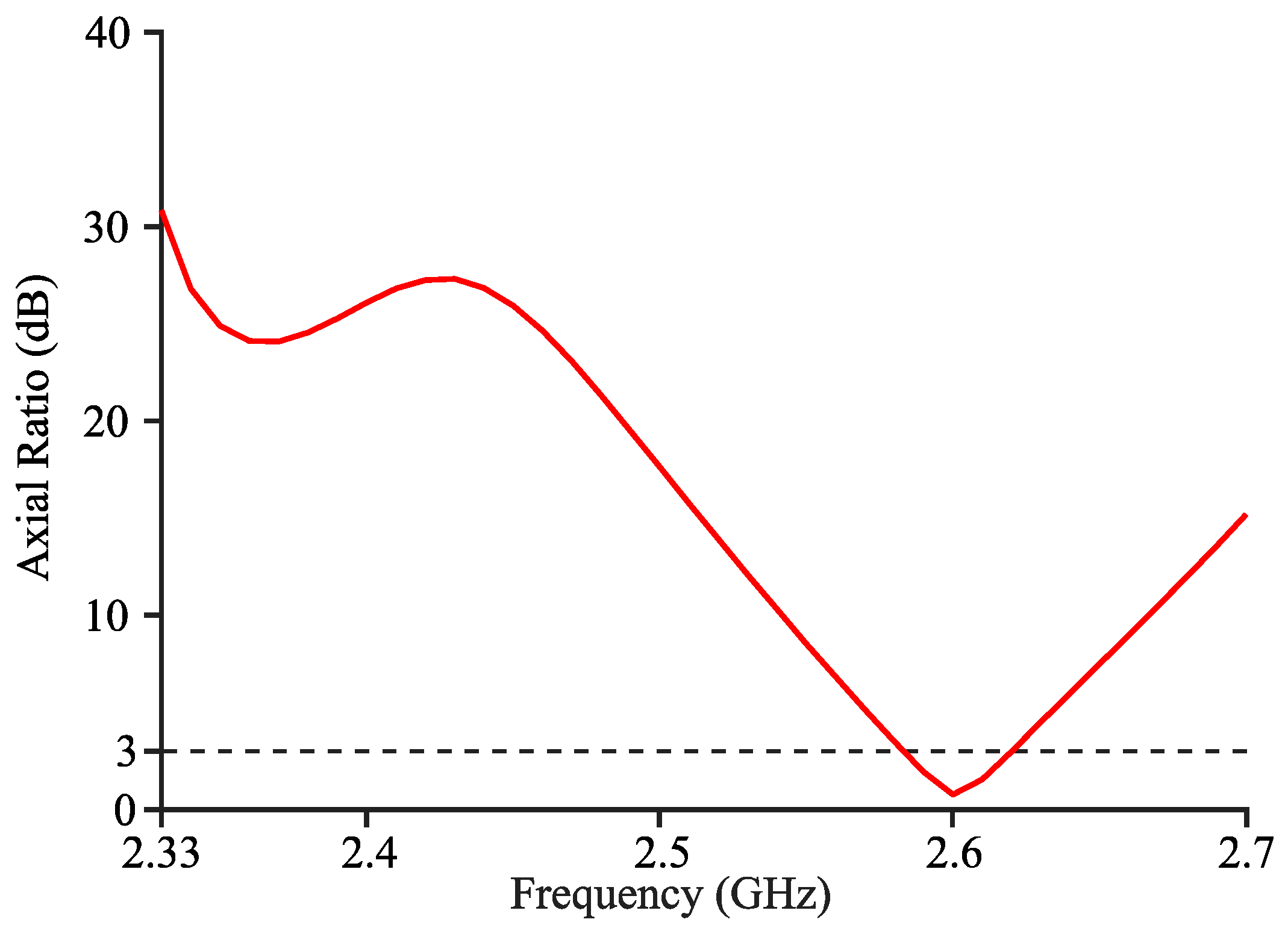

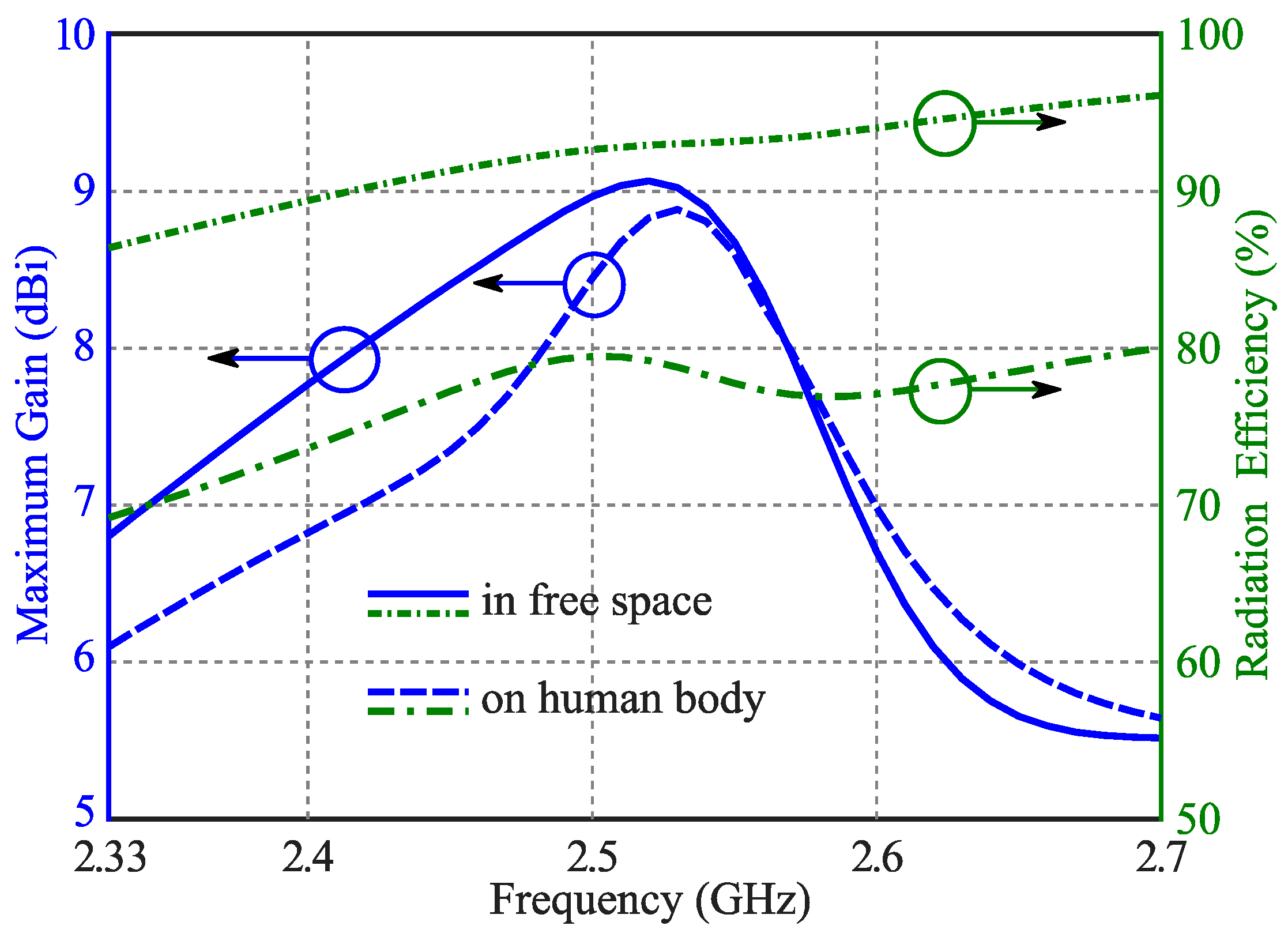
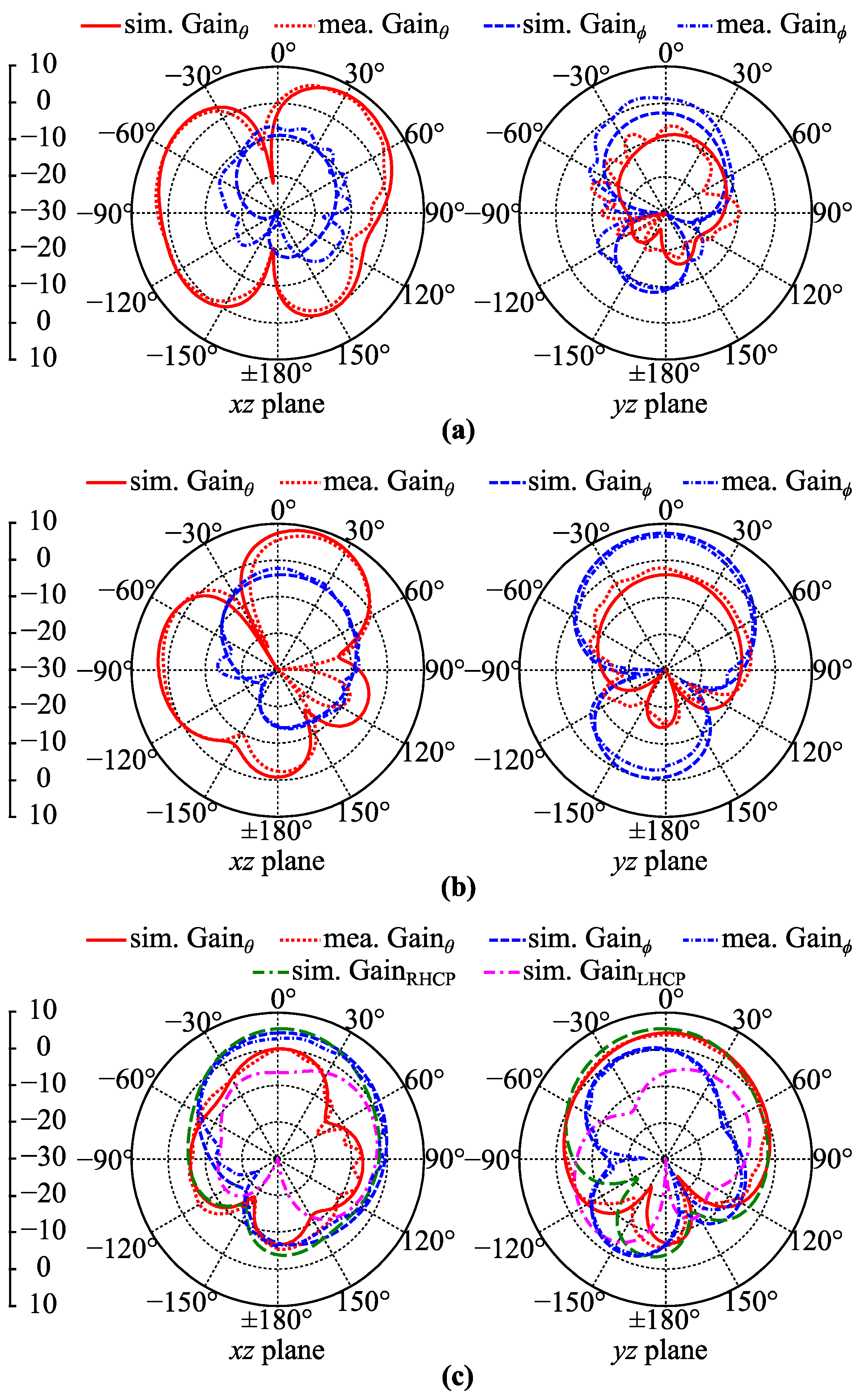
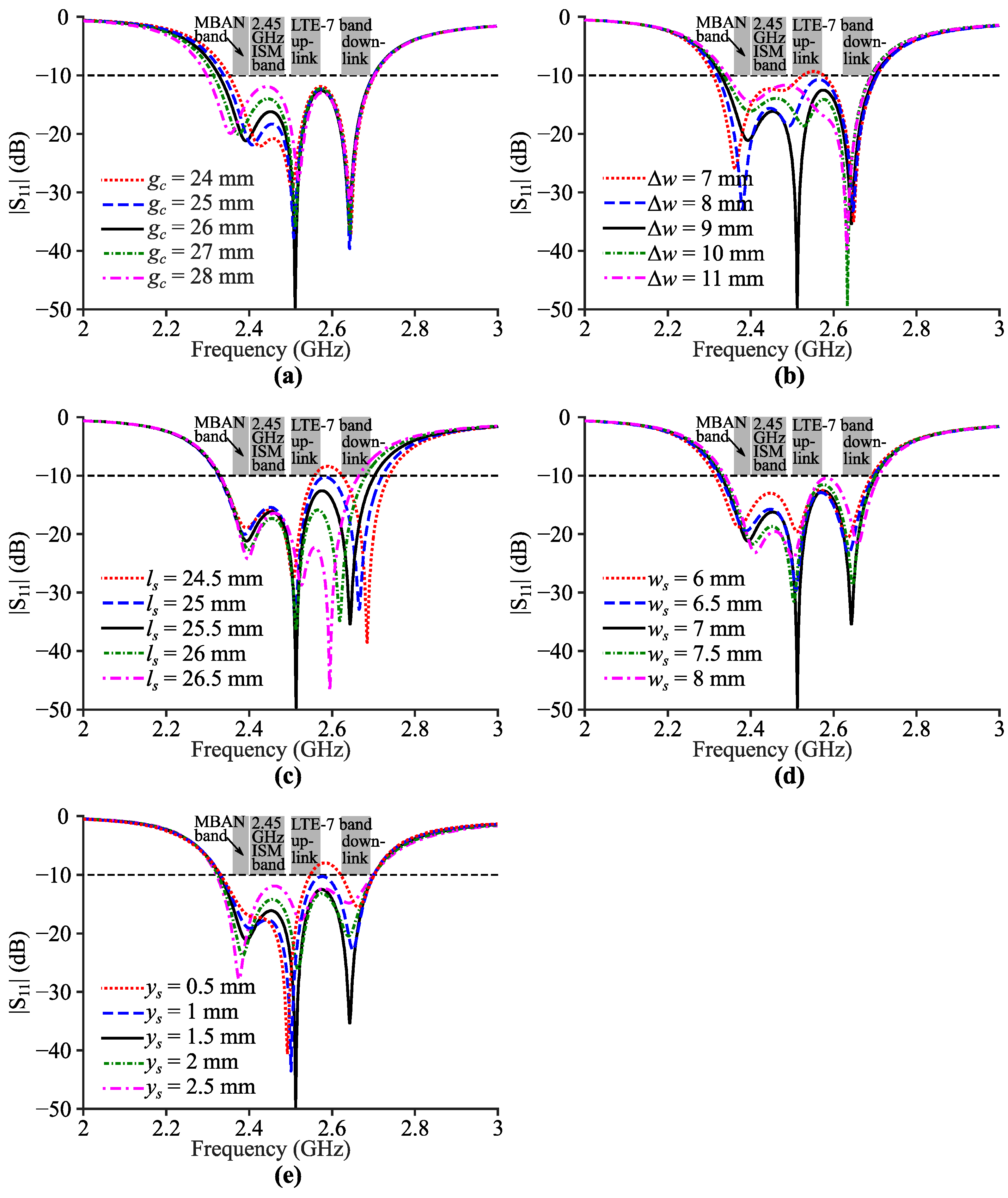



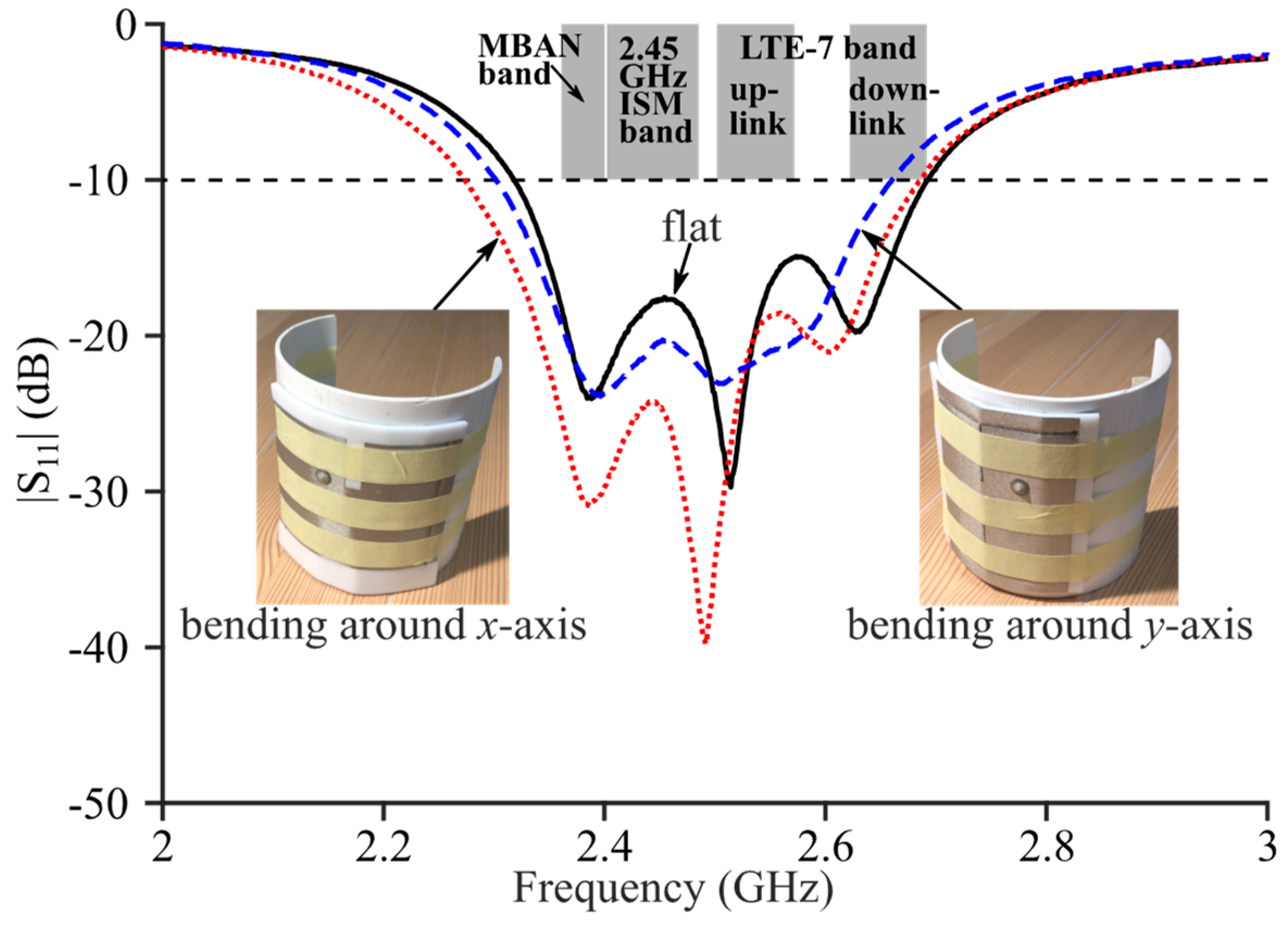
| w (mm) | l (mm) | xf (mm) | yf (mm) | gc (mm) | ∆w (mm) | ws (mm) | ls (mm) | ys (mm) | |
|---|---|---|---|---|---|---|---|---|---|
| Antenna I | 41.8 | 83.6 | 10.8 | - | - | - | - | - | - |
| Antenna II | 39 | 78 | 11 | - | 24.5 | 2 | - | - | - |
| Antenna III | 42 | 84 | 18 | 13 | 26 | 9 | 7 | 25.5 | 1.5 |
| Relative Permittivity | Conductivity (S/m) | Density (kg/m3) | Thickness (mm) | |
|---|---|---|---|---|
| Skin | 38.09 | 1.43 | 1100 | 2 |
| Fat | 5.29 | 0.1 | 910 | 5 |
| Muscle | 52.8 | 1.69 | 1041 | 20 |
| Bone | 11.4 | 0.381 | 1908 | 13 |
| Freq. (GHz) | Bandwidth (%) | Gainmax (dBi) | Efficiency (%) | Cavity Size (λε2) | |
|---|---|---|---|---|---|
| [20] | 5.5 | 23.7 | 4.3 | 85 | 0.364 |
| [17] | 2.45 | 16.2 | 4.7 | 67~82 | 0.096 |
| [21] | 2.45 | 6 | not given | not given | 0.220 |
| [22] | 5.5 | 18 | 5.9 | 74.1 | 0.662 |
| [23] | 5.5 | 14.7 | 8.8 | ≥95 | 1.073 |
| This work | 2.5 | 14.9 | 5.5~9.1 | 86~96 | 0.466 |
Publisher’s Note: MDPI stays neutral with regard to jurisdictional claims in published maps and institutional affiliations. |
© 2022 by the authors. Licensee MDPI, Basel, Switzerland. This article is an open access article distributed under the terms and conditions of the Creative Commons Attribution (CC BY) license (https://creativecommons.org/licenses/by/4.0/).
Share and Cite
Cui, J.; Liu, F.-X.; Shen, X.; Zhao, L.; Yin, H. Textile Bandwidth-Enhanced Coupled-Mode Substrate-Integrated Cavity Antenna with Slot. Electronics 2022, 11, 2454. https://doi.org/10.3390/electronics11152454
Cui J, Liu F-X, Shen X, Zhao L, Yin H. Textile Bandwidth-Enhanced Coupled-Mode Substrate-Integrated Cavity Antenna with Slot. Electronics. 2022; 11(15):2454. https://doi.org/10.3390/electronics11152454
Chicago/Turabian StyleCui, Jie, Feng-Xue Liu, Xiaopeng Shen, Lei Zhao, and Hongsheng Yin. 2022. "Textile Bandwidth-Enhanced Coupled-Mode Substrate-Integrated Cavity Antenna with Slot" Electronics 11, no. 15: 2454. https://doi.org/10.3390/electronics11152454






